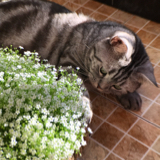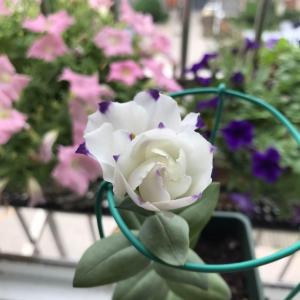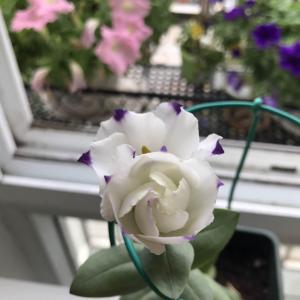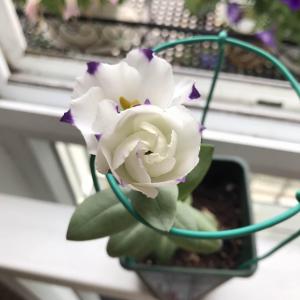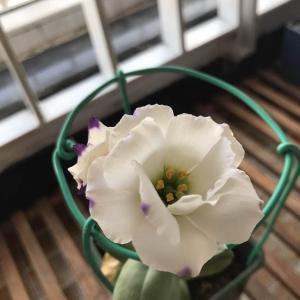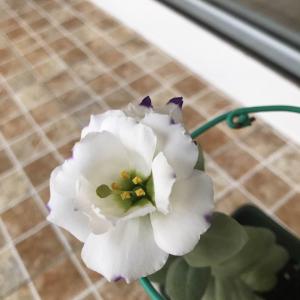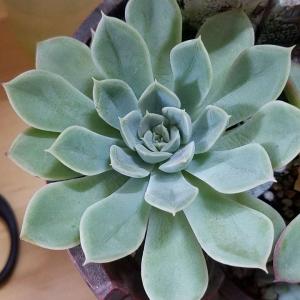文章
Miss Chen
2017年08月05日


Description: This is a low prostrate shrub about 2-8" tall that branches occasionally, often forming a mat of trailing branches and leafy shoots. The older branches are woody with thin bark; young shoots are whitish green to red, more or less pubescent, and terete (circular in circumference). Alternate evergreen leaves occur along the young shoots; these leaves are ascending to widely spreading, and they overlap more toward the tips of shoots than toward their bases. Individual leaves are ½–1" long and ¼–½" across; they are oblanceolate or oblanceolate-elliptic in shape, while their margins are entire (toothless) and slightly ciliate. The upper leaf surface is dark green, hairless, and shiny, while the lower leaf surface is medium green and hairless. Leaf texture is leathery and leaf venation is pinnate. The leaves taper gradually into short petioles about 1/8" (3 mm.) long. Short clusters of 2-15 drooping flowers are produced from the tips of last year's twigs. Each flower is about ½" long and ½" across, consisting of a white to pink urn-shaped corolla, a very short calyx with 5 half-orbicular lobes, 10 inserted stamens, and a glabrous ovary with an inserted style.
Mature Drupes
The corolla is constricted around its neck, above which there are 5 tiny lobes that are recurved and half-orbicular in shape. The interior of the corolla is hairy. The lobed calyx is predominately light green to red; its lobes have white- membranous margins. Both the peduncle and pedicels of the inflorescence are light green to red, glabrous to short-pubescent, and terete. The blooming period occurs from late spring to early summer, lasting about 2-3 weeks. Afterwards, fertile flowers are replaced by drupes that develop during the summer. Mature drupes are ¼–½" across, globoid to subgloboid in shape, smooth, and bright red. The fleshy interior of each mature drupe is dry, mealy, and tasteless, containing 4-5 hard seeds that are irregularly shaped. The woody root system can extend 3-6' into the ground. This shrub reproduces primarily by layering; when its branches and shoots become submerged in sand or soil, they can develop new roots. By this means, clonal colonies are produced. To a lesser extent, this shrub also reproduces by reseeding itself. The evergreen leaves become red to dark red during the winter.
Cultivation: The preference is full or partial sun, dry conditions, and sterile soil containing acidic rocky material or sand. Growth and development is slow. This winter-hardy evergreen shrub can be started from rooted cuttings. It can be used as a low ground cover in sunny rock gardens. The long-lasting drupes can persist into autumn, winter, and early spring.
Range & Habitat: The native Bearberry occurs primarily in northern Illinois, where it is rare and state-listed as 'endangered' (see Distribution Map). However, some large healthy populations of this low shrub can be found along the sand dunes of Lake Michigan. Illinois lies along the southern range-limit of this species. Bearberry has a wide distribution in boreal areas of North America; it also occurs in boreal areas of Eurasia. Habitats include dry sandy woodlands, dry sandy prairies, sandstone glades, exposed sandstone cliffs, and sand dunes along Lake Michigan. In the latter habitat, Bearberry is often codominant with Trailing Juniper (Juniperus horizontalis). This conservative shrub is found in high quality natural areas. It is also cultivated occasionally in gardens. Wildfire resistant is relatively poor, although some crowns and submerged rooted branches can survive light fires (Crane, 1991).
Faunal Associations: The urn-shaped flowers are probably cross-pollinated by long-tongued bees, where both nectar and pollen are available as floral rewards. A relatively small number of insects feed on the leaves and other parts of Bearberry. These species include two aphids, Tamalia coweni and Wahlgreniella nervata; Clastoptera saintcyri (Heath Spittlebug); two leafhoppers, Limotettix arctostaphyli and Texananus cumulatus; the larvae of two butterflies, Callophrys augustinus (Brown Elfin) and Callophrys polios (Hoary Elfin); and the larvae of a Pyralid moth, Pyla arenaeola (see Hottes & Frison, 1931; Hamilton, 1982; DeLong, 1948; Opler & Krizek, 1984; and Panzer et al., 2006). Two polyphagous insects, Lepidosaphes ulmi (Oystershell Scale) and Pseudococcus sorghiellus (Trochanter Mealybug), also reportedly feed on Bearberry. Foliage of Bearberry is browsed sparingly by White-tailed Deer and Elk. However, it is consider unpalatable and slightly toxic to horses, cattle, and other livestock. The fruits of this shrub are eaten by various upland gamebirds, songbirds, black bears, and small mammals, especially during the winter and early spring, as a source of emergency food (see Crane, 1991; Martin et al., 1951/1961; Rumble & Anderson, 1996). Most of these observations for vertebrate animals have occurred in the western United States and Canada.
Photographic Location: Sand dunes along Lake Michigan at Illinois Beach State Park in NE Illinois.
Comments: Along with Trailing Juniper (Juniperus horizontalis), Bearberry (Arctostaphylos uva-ursi) plays an important role in stabilizing the sand dunes along Lake Michigan in NE Illinois. It is typically found along the slopes or the tops of such dunes. Taller shrubs that colonize this area include Low Common Juniper (Juniperus communis depressa), Sand Cherry (Prunus pumila), and Chokecherry (Prunus virginiana). Bearberry has attractive flowers, fruits, and foliage throughout the year. Because of its wide distribution, there is some variability across different populations, and different varieties/subspecies have been described. Bearberry resembles another species in the Heath family, American Wintergreen (Gaultheria procumbens), in appearance. This latter species can be distinguished by its somewhat larger leaves (1-2" long), the wintergreen aroma of its leaves when they are crushed, the spicy flavor of its fruits, and the more pointed calyces of its flowers. It produces solitary flowers from the leaf axils, rather than clusters of 2-15 flowers from the tips of twigs. Another common name of Arctostaphylos uva-ursi is Kinnikinnik. This was originally an Amerindian name for this shrub; its dried leaves were often used as an ingredient in tobacco by them.

0
0
文章
Miss Chen
2017年08月05日


Description: This perennial plant consists of a tuft of basal leaves from which one or more flowering stalks emerge. The basal leaves are erect, ascending, or arching; they are up to 12" long and up to 8 mm. across. The basal leaves are linear in shape, medium green, glabrous, and smooth along their margins; they are solid and flattened. Leaf venation is parallel. Each leaf is slightly keeled along its midvein. The flowering stalks are up to 1½' long and more or less erect; they are light green or light reddish purple, glabrous, and terete. Each stalk terminates in a nodding umbel of flowers that emerges from a pair of sack-like membranes; these membranes are deciduous. Each umbel spans about 1½–2" across, consisting of 40-60 pedicellate flowers.
The flowers are individually about ¼" (6 mm.) across, consisting of 6 spreading tepals, 6 exserted stamens, and an ovary with a style. The tepals are white, light lavender, or pink; they are lanceolate in shape. The stamens have white filaments and yellow anthers. The pedicels are ½–1" long; they are light green or light reddish purple, glabrous, and more or less terete. The blooming season usually occurs during mid-summer, lasting 3-4 weeks. There is no noticeable floral scent. Afterwards, the flowers are replaced by seed capsules; each capsule contains several small black seeds that it splits open to release. The root system consists of a bulb that is longer than it is wide. Both the bulb and foliage of this plant have a typical onion-like scent. Clonal offsets are produced, forming new bulbs underground.
Cultivation: The preference is full to partial sun, moist to mesic conditions, and soil containing black loam, sand, or rocky material. While this plant can survive hot dry summers, it does better with more moisture. Foliar disease is rarely a problem. This plant is easy to grow under cultivation, and it will spread gradually under suitable conditions. It is easier to establish plants by transplanting the bulbs of offsets, rather than by attempting to germinate the seeds.
Range & Habitat: Nodding Onion is an uncommon plant that occurs only in NE Illinois (see Distribution Map), where it is native. Habitats include black soil prairies, sandy pannes, and thinly wooded bluffs. Much of the prairie habitat where this plant once occurred has been destroyed by development. Nodding Onion is normally found in high-quality natural areas, although it could escape from cultivation into more disturbed areas.
Faunal Associations: The nectar and pollen of the nodding flowers attract primarily bees, including honeybees, bumblebees, Anthophorine bees (Anthophora spp.), and Halictid bees (Lasioglossum spp.). Insects that feed destructively on the foliage, bulbs, and other parts of Nodding Onion and other onion species (Allium spp.) include the Onion Plant Bug (Lindbergocapsus allii) and a similar plant bug (Lindbergocapsus ainsliei), larvae of the False Japanese Beetle (Strigoderma arbicola), larvae of the Onion Maggot (Delia antiqua), larvae of the Black Onion fly (Tritoxa flava), larvae of the Onion Bulb Fly (Eumerus strigatus), and Onion Thrips (Thrips tabaci). Mammalian herbivores usually avoid Allium spp., although cattle and other livestock may browse on their foliage along with the grass in pastures, causing an off-flavor in their milk.
Photographic Location: The photographs were taken at the wildflower garden of the webmaster in Urbana, Illinois, and at a restored prairie in Meadowbrook Park of the same city.
Comments: This plant is easy to identify because of the nodding habit of its umbels of flowers. Nodding umbels of flowers are an evolutionary adaptation that tends to restrict insect visitors to bees. Other insects are more reluctant to hang upside down while attempting to feed on nectar or pollen. The nodding habit may also protect the nectar from rain. Compared to 2 other species that are native, the Cliff Onion (Allium stellatum) and Wild Garlic (Allium canadense), Nodding Onion (Allium cernuum) has wider leaves. Compared to the non-native Field Garlic (Allium vineale), Chives (Allium schoenoprasum), and Cultivated Onion (Allium cepa), the leaves of Nodding Onion are flattened and solid throughout, rather than hollow.

0
0
文章
Dummer. ゛☀
2017年07月31日

Family - Lauraceae
Stems - Stems to 5m tall, multiple from the base. Twigs glabrous, olive-brown, with small lenticels.

Inflorescence - Staminate flowers in a few-flowered (4-8) fascicle, emerging with the new leaves. Pedicels glabrous, to 3mm long (slightly longer in fruit).
Flowers - Petals absent. Sepals 6, greenish-yellow to scarious-yellow, 2.3mm long, 1.5mm broad, glabrous, rounded at the apex, oblong-obovate. Stamens 9 (in staminate flowers), alternating with smaller capitate staminodes. Filaments glabrous, to 1.8mm long. All floral organs united at the base. Reduced ovary in staminate flowers to -1mm long. Drupe bright red, ovoid, to 1cm long, 5mm broad.

Flowering - March - May.
Habitat - Low moist woods, bottoms, thickets along streams, base of bluffs, seeps along wooded slopes.
Origin - Native to U.S.
Other info. - This shrubby species is easy to identify in the field because of its habitat and its pleasant fragrance. When crushed, the leaves give off a lemon scent that is reminiscent of "Pledge" furniture polish. The small flowers of the plant are some of the first to be seen in the spring. They are short lived and the plant is typically seen with just leaves or in fruit. This is a dioeceous species, meaning plants will have either male or female flowers. Staminate plants typically have many more flowers than pistillate plants.
Natives used a tea made from all parts of the plant to treat ailments such as coughs, cramps, measels, and anemia. Oil from the fruits was applied to bruises. A tea made from the bark was used to expel parasitic worms. The tea is quite good, if a sweetener is added. (give me a break, I'm from the south)
A similar species, L. melissaefolium (Walt.) Blume, is extremely rare in Missouri and is endangered in North America. This latter species occurs in just one southern Missouri County (Ripley). L. melissaefolium has larger fruits than L. benzoin and more rhombic leaves. The leaves are shown below:
Stems - Stems to 5m tall, multiple from the base. Twigs glabrous, olive-brown, with small lenticels.

Inflorescence - Staminate flowers in a few-flowered (4-8) fascicle, emerging with the new leaves. Pedicels glabrous, to 3mm long (slightly longer in fruit).
Flowers - Petals absent. Sepals 6, greenish-yellow to scarious-yellow, 2.3mm long, 1.5mm broad, glabrous, rounded at the apex, oblong-obovate. Stamens 9 (in staminate flowers), alternating with smaller capitate staminodes. Filaments glabrous, to 1.8mm long. All floral organs united at the base. Reduced ovary in staminate flowers to -1mm long. Drupe bright red, ovoid, to 1cm long, 5mm broad.

Flowering - March - May.
Habitat - Low moist woods, bottoms, thickets along streams, base of bluffs, seeps along wooded slopes.
Origin - Native to U.S.
Other info. - This shrubby species is easy to identify in the field because of its habitat and its pleasant fragrance. When crushed, the leaves give off a lemon scent that is reminiscent of "Pledge" furniture polish. The small flowers of the plant are some of the first to be seen in the spring. They are short lived and the plant is typically seen with just leaves or in fruit. This is a dioeceous species, meaning plants will have either male or female flowers. Staminate plants typically have many more flowers than pistillate plants.

Natives used a tea made from all parts of the plant to treat ailments such as coughs, cramps, measels, and anemia. Oil from the fruits was applied to bruises. A tea made from the bark was used to expel parasitic worms. The tea is quite good, if a sweetener is added. (give me a break, I'm from the south)
A similar species, L. melissaefolium (Walt.) Blume, is extremely rare in Missouri and is endangered in North America. This latter species occurs in just one southern Missouri County (Ripley). L. melissaefolium has larger fruits than L. benzoin and more rhombic leaves. The leaves are shown below:
0
0
文章
权问薇
2017年07月23日


栀子
1、选取健壮的栀子花枝条,最好是当年新生的嫩枝然后截去8~10cm左右的一条即可。
2、将枝条的下半部分斜切,好漏出更多的横截面,能够促进生根。
3、准备一个塑料瓶或者是杯子,或者是其他不漏水的容器。
4、将栀子花的枝条插进水中即可。(如果容器的口比较大,可以和图中一样,用塑料泡沫固定住,然后浮在水面上即可)
5、夏天天气炎热,因此要一天换一次水,大概半个月或者是1个月的时间就可以生根了!
6、生根后,大概有2条三公分左右的白根就可以移栽了!
虎皮兰
1、选取健康的虎皮兰叶片,从顶部剪下来6~7cm的一截。
2、准备好不漏水的容器。
3、将虎皮兰伤口处在多菌灵溶液中浸泡15分钟左右,然后阴干。
4、将虎皮兰插进水里即可~
5、在生根之前记得每天换水哦~大概半个月的时间,虎皮兰就能生根了,然后上盆即可。
幸福树
1、选择健壮的1~2年生幸福树枝条,注意是要木质化的哦~取15~20cm左右即可~
2、将伤口处放在高锰酸钾溶液中浸泡半个小时左右,然后阴干。
3、将容器清洗干净,倒入干净的水。
4、将幸福树的枝条插进土壤中即可,不过,在没有生根之前,要一天换一次水哦~
5、大概半个月或者是一个月左右的时间,就能生根了!
发财树
1、选取一截比较健壮的发财树枝条哦~然后用多菌灵消毒杀菌。
2、准备干净的容器,装上水,大概三分之二就可以了~
3、将发财树的枝条插进去即可,注意一天换一次水哦~
薄荷
1、选取健壮枝条,剪下来吗,记得留最少2个节点哦~
2、将扦插用的容器清洗干净,装满水。将薄荷插进水里即可。
3、薄荷生根真的超级快,基本上2天就会有根冒出来了!
0
1
文章
丫头
2017年07月20日

露台种什么植物好,由于露台种#葡萄 的方法也不是很难,所以有花友会选择葡萄,其实露台和阳台都可以种葡萄,只要保证有一定土量,有6-8小时以上的日照即可。
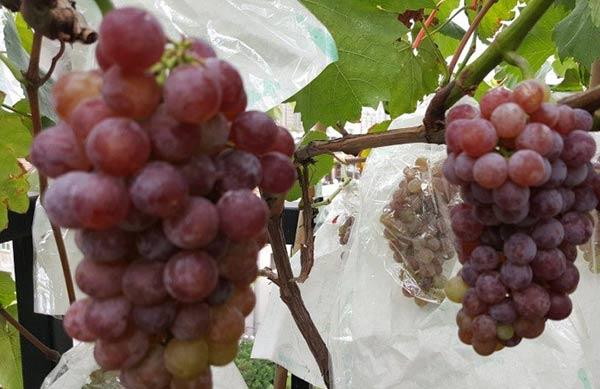
如果选择葡萄速产品种,头年种,第二年就有果吃。下面,以时间顺序告诉你,怎么从零开始种葡萄。种植的地点假设是长江流域以南,北方的朋友在种植时间上可能会稍微推后。
第一年
1月份买苗种植(或者上一年12月买也可)。
关于土:种植土越多越好,有花池最好,没有的话用泡沫箱拼起来种。土可以事先准备好,最好用大量的杂草树叶打底,上面用园土,掺五分之一的锯末或者珍珠岩以保证疏松透气。种苗的土不能太肥,土要压实让根紧密接触土。
关于苗:某宝上的什么5年大苗8年大苗之类全是忽悠你的,种葡萄最好就是用1年苗,这样苗长势旺,第二年就可以结果,第3年开始丰产。很多老树一般是葡萄园淘汰下来的,树势衰弱,根不好,将来种了后难丰产。
葡萄长三年就是树了,可有3指粗,所以某宝上买个5年苗,寄过来只有1个指头初粗,那更是骗死你不偿命。苗买回来是光杆,把它种下去,浇透水就行了,这时候天气寒冷,不用多浇水,只要土壤不太干就行。
新手或者雨水多的地方,可选好种的品种,巨峰夏黑寒香蜜白香蕉摩尔多瓦雨水红之类都可以。其中摩尔多瓦是很容易有成就感的品种,容易结果且不容易生病,也没有落果落花裂果等毛病,只是口感偏淡一点,要注意这个品种先上色再上糖,所以变黑后再挂上一个月才好吃,这时候就比较甜了。
4月-5月:
4月初苗开始发芽,注意买的苗一般是嫁接苗,在嫁接口处有塑料膜绑着,苗发芽后要去掉塑料膜。嫁接口以下发出来的芽要全部去掉,上面发出来的芽选一个壮枝保留,其余全部去掉。
这个枝长出8片叶子后,摘心。摘心后很多叶子根部会发出芽来,只留最顶上一个芽让它长成主枝,其余的芽留2片叶子打顶。这个芽叫夏芽,因为它是夏天发出。每片叶子根部还有另外一个芽,这个芽今年不会萌发,会在来年春天发,这个芽叫冬芽。冬芽就是明年结果枝的芽,摘心的目的就是要让它养壮。最顶上的夏芽反复不断摘心,每次留7、6、5、4片叶子反复摘心。如果你是花池栽,葡萄长得粗,那么可以多留几根夏芽发出来的枝作为主枝,按照8、7、6....的方法反复摘心也行。
苗开始长出卷须来后可以开始施肥,施少量氮肥,尿素融水就行,要薄肥勤施,千万不要把葡萄肥死了。苗长大后每周一次用复合肥融水施就可以,当然也可以加饼肥、鸡粪等有机肥,注意适量。5月份叶片长大后,可以喷页面肥,用尿素和磷酸二氢钾融水,都是千分之2浓度就可以了,重点喷叶的背面,正面也喷点。葡萄所有的卷须都要剪掉,避免耗费营养,另外用绳子把葡萄枝绑在架子上。
下图是我15年种的1年苗,这是寒香蜜,注意看红圈是嫁接口,红圈以下的那根枝要去掉,只留上面的那一个芽。这样小小的一根苗,16年就能结出大量的果子。

6月
开始进入梅雨季节,要做好葡萄的防病,可以用波尔多液喷叶片正反面,特别是下大雨前要喷,连续阴雨后要喷。把露台环境弄干净,不要到处是残枝落叶,那样容易产生病菌。
7月
葡萄这时进入花芽分化期,这是明年能否丰收的关键。土里少量施硼酸和硫酸锌,另外再用磷酸二氢钾加尿素溶液喷叶,最好10天一次。磷酸二氢钾注意要买正品,花鸟市场里90%的是假的,可上某宝买国光牌的。
8月-11月8月到9月酷暑季节,要注意葡萄的浇水,露台上一般要早晚各一次,保证不缺水。10月到11月,葡萄再次进入长根期,这时候还是注意薄肥勤施,经常用千分之二磷酸二氢钾溶液浇灌,可以促根。但是切记切记不要浓了,新手最容易犯的错就是肥死葡萄。到11月份,可以在离葡萄根30公分远的地方,挖坑埋入鱼肠之类的荤肥,葡萄最喜欢,来年葡萄又大又甜。如果是泡沫箱种,那就在箱子边上少量埋点鱼肠,或者煮熟的鸡蛋打个小孔,埋土里也可。
12月
葡萄叶子掉光后,开始剪枝。今年培养的主枝,每根主枝留底部5-6个芽,其余上面的枝子剪去。如果是独杆主枝,可以多留点芽。
第二年
4月份葡萄开始发芽,这时候,去年的冬芽发出来,会有花穗。如下图所示(图中是巨峰的花穗):

花穗出来后,特别要注意的就是保花保果。注意以下几点:
一是发芽后到出现花穗时要尽量少用氮肥,如果去年的葡萄壮,有机肥施得足,可以不用氮肥,如果不是很壮,发芽时施一次尿素溶液即可,后面不要施了,另外花期要少浇水,保持土不干即可。水多了,氮肥多了容易落花。
二是注意叶面喷硼肥和锌肥,用千分之2到3的浓度,10天一次,喷2-3次。另外还可喷磷酸二氢钾等叶面肥。
三是要注意防病,这时灰霉病和穗轴褐枯病是葡萄落花的两大杀手,花穗长到6-7公分长后,可在花上喷一次凯泽防病。
5月份
这时葡萄开花了,对于寒香蜜摩尔多瓦白香蕉等品种来说,可以不用管它,自然坐果很好。如果是巨峰夏黑巨玫瑰红富士等巨峰系的品种,由于品种特点就是落花落果,所以要注意保果。可以用某宝上的美国奇宝来保果。它其实就是赤霉酸,是安全的,它是生物提炼的,也是国家最高档次AA级绿色农产品标准允许使用的。如果你担心,想一想用一瓶啤酒,让它的水分蒸发掉90%,剩下的溶液用来保果,是一样的效果,因为这时剩下的溶液就是百万分之二十浓度的赤霉酸(啤酒里含百万分之二的赤霉酸)。下面是奇宝,一包有200毫克赤霉酸,溶解到20斤水里面,就是百万分之二十浓度赤霉酸。
葡萄一穗花全开时,喷赤霉酸一次,12天后再喷一次就可以了。
6月份
葡萄结出小果实了,这时可以在果穗上喷一次波尔多液保护,然后就可以套袋了。套袋的作用是防病和防鸟。葡萄坐果坐稳后,就要大肥大水,促进葡萄果实增大,这时候要多施速效氮肥,可以用尿素水浇施。
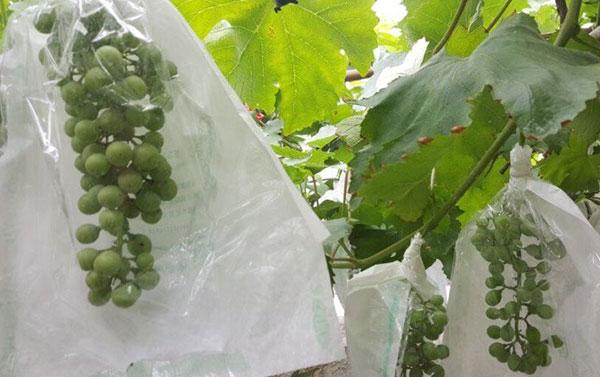
6月中旬-8月
这是葡萄果实成熟的季节,想要葡萄甜,上色好,就要注意多施钾肥,一是注意多用鸡粪,二是可以用磷酸二氢钾喷叶,或者高钾水溶肥浇灌。这样葡萄就可以长得漂亮又甜。


如果选择葡萄速产品种,头年种,第二年就有果吃。下面,以时间顺序告诉你,怎么从零开始种葡萄。种植的地点假设是长江流域以南,北方的朋友在种植时间上可能会稍微推后。
第一年
1月份买苗种植(或者上一年12月买也可)。
关于土:种植土越多越好,有花池最好,没有的话用泡沫箱拼起来种。土可以事先准备好,最好用大量的杂草树叶打底,上面用园土,掺五分之一的锯末或者珍珠岩以保证疏松透气。种苗的土不能太肥,土要压实让根紧密接触土。
关于苗:某宝上的什么5年大苗8年大苗之类全是忽悠你的,种葡萄最好就是用1年苗,这样苗长势旺,第二年就可以结果,第3年开始丰产。很多老树一般是葡萄园淘汰下来的,树势衰弱,根不好,将来种了后难丰产。
葡萄长三年就是树了,可有3指粗,所以某宝上买个5年苗,寄过来只有1个指头初粗,那更是骗死你不偿命。苗买回来是光杆,把它种下去,浇透水就行了,这时候天气寒冷,不用多浇水,只要土壤不太干就行。
新手或者雨水多的地方,可选好种的品种,巨峰夏黑寒香蜜白香蕉摩尔多瓦雨水红之类都可以。其中摩尔多瓦是很容易有成就感的品种,容易结果且不容易生病,也没有落果落花裂果等毛病,只是口感偏淡一点,要注意这个品种先上色再上糖,所以变黑后再挂上一个月才好吃,这时候就比较甜了。
4月-5月:
4月初苗开始发芽,注意买的苗一般是嫁接苗,在嫁接口处有塑料膜绑着,苗发芽后要去掉塑料膜。嫁接口以下发出来的芽要全部去掉,上面发出来的芽选一个壮枝保留,其余全部去掉。
这个枝长出8片叶子后,摘心。摘心后很多叶子根部会发出芽来,只留最顶上一个芽让它长成主枝,其余的芽留2片叶子打顶。这个芽叫夏芽,因为它是夏天发出。每片叶子根部还有另外一个芽,这个芽今年不会萌发,会在来年春天发,这个芽叫冬芽。冬芽就是明年结果枝的芽,摘心的目的就是要让它养壮。最顶上的夏芽反复不断摘心,每次留7、6、5、4片叶子反复摘心。如果你是花池栽,葡萄长得粗,那么可以多留几根夏芽发出来的枝作为主枝,按照8、7、6....的方法反复摘心也行。
苗开始长出卷须来后可以开始施肥,施少量氮肥,尿素融水就行,要薄肥勤施,千万不要把葡萄肥死了。苗长大后每周一次用复合肥融水施就可以,当然也可以加饼肥、鸡粪等有机肥,注意适量。5月份叶片长大后,可以喷页面肥,用尿素和磷酸二氢钾融水,都是千分之2浓度就可以了,重点喷叶的背面,正面也喷点。葡萄所有的卷须都要剪掉,避免耗费营养,另外用绳子把葡萄枝绑在架子上。
下图是我15年种的1年苗,这是寒香蜜,注意看红圈是嫁接口,红圈以下的那根枝要去掉,只留上面的那一个芽。这样小小的一根苗,16年就能结出大量的果子。

6月
开始进入梅雨季节,要做好葡萄的防病,可以用波尔多液喷叶片正反面,特别是下大雨前要喷,连续阴雨后要喷。把露台环境弄干净,不要到处是残枝落叶,那样容易产生病菌。
7月
葡萄这时进入花芽分化期,这是明年能否丰收的关键。土里少量施硼酸和硫酸锌,另外再用磷酸二氢钾加尿素溶液喷叶,最好10天一次。磷酸二氢钾注意要买正品,花鸟市场里90%的是假的,可上某宝买国光牌的。
8月-11月8月到9月酷暑季节,要注意葡萄的浇水,露台上一般要早晚各一次,保证不缺水。10月到11月,葡萄再次进入长根期,这时候还是注意薄肥勤施,经常用千分之二磷酸二氢钾溶液浇灌,可以促根。但是切记切记不要浓了,新手最容易犯的错就是肥死葡萄。到11月份,可以在离葡萄根30公分远的地方,挖坑埋入鱼肠之类的荤肥,葡萄最喜欢,来年葡萄又大又甜。如果是泡沫箱种,那就在箱子边上少量埋点鱼肠,或者煮熟的鸡蛋打个小孔,埋土里也可。
12月
葡萄叶子掉光后,开始剪枝。今年培养的主枝,每根主枝留底部5-6个芽,其余上面的枝子剪去。如果是独杆主枝,可以多留点芽。
第二年
4月份葡萄开始发芽,这时候,去年的冬芽发出来,会有花穗。如下图所示(图中是巨峰的花穗):

花穗出来后,特别要注意的就是保花保果。注意以下几点:
一是发芽后到出现花穗时要尽量少用氮肥,如果去年的葡萄壮,有机肥施得足,可以不用氮肥,如果不是很壮,发芽时施一次尿素溶液即可,后面不要施了,另外花期要少浇水,保持土不干即可。水多了,氮肥多了容易落花。
二是注意叶面喷硼肥和锌肥,用千分之2到3的浓度,10天一次,喷2-3次。另外还可喷磷酸二氢钾等叶面肥。
三是要注意防病,这时灰霉病和穗轴褐枯病是葡萄落花的两大杀手,花穗长到6-7公分长后,可在花上喷一次凯泽防病。
5月份
这时葡萄开花了,对于寒香蜜摩尔多瓦白香蕉等品种来说,可以不用管它,自然坐果很好。如果是巨峰夏黑巨玫瑰红富士等巨峰系的品种,由于品种特点就是落花落果,所以要注意保果。可以用某宝上的美国奇宝来保果。它其实就是赤霉酸,是安全的,它是生物提炼的,也是国家最高档次AA级绿色农产品标准允许使用的。如果你担心,想一想用一瓶啤酒,让它的水分蒸发掉90%,剩下的溶液用来保果,是一样的效果,因为这时剩下的溶液就是百万分之二十浓度的赤霉酸(啤酒里含百万分之二的赤霉酸)。下面是奇宝,一包有200毫克赤霉酸,溶解到20斤水里面,就是百万分之二十浓度赤霉酸。
葡萄一穗花全开时,喷赤霉酸一次,12天后再喷一次就可以了。
6月份
葡萄结出小果实了,这时可以在果穗上喷一次波尔多液保护,然后就可以套袋了。套袋的作用是防病和防鸟。葡萄坐果坐稳后,就要大肥大水,促进葡萄果实增大,这时候要多施速效氮肥,可以用尿素水浇施。

6月中旬-8月
这是葡萄果实成熟的季节,想要葡萄甜,上色好,就要注意多施钾肥,一是注意多用鸡粪,二是可以用磷酸二氢钾喷叶,或者高钾水溶肥浇灌。这样葡萄就可以长得漂亮又甜。

2
9
文章
Miss Chen
2017年07月19日


Nombre científico o latino: Ceanothus arboreus
Nombre común o vulgar: Ceanoto arbóreo, Lilo de las montañas de Catalina.
Familia: Rhamnaceae.
Arbusto erecto grande, que alcanza 3-8 m.
Hojas perennes.
Flores azules en primavera.
Clima cálidos, sin heladas.
Luz: sol o semisombra.
Suelo con un buen drenaje. No le gusta los suelos excesivamente calcáreos.
En regiones húmedas o lluviosas necesita invernadero.
Poda después de pasar la floración.
Multiplicación de Ceanothus:
Su propagación se puede hacer por semillas, estacas, acodos y algunas veces por injerto.
Semillas.
Las semillas se deben recolectar poco tiempo antes que las cápsulas se abran, pues de otro modo se pierden.

Las semillas de la mayoría de especies de Ceanothus tienen sólo letargo de la cubierta de la semilla.
Colocando las semillas en agua caliente de 82 a 87ºC y dejándola enfriar por 12 a 24 h o aun hirviéndolas en agua durante 5 min, ayuda a la germinación.
Para lograr la germinación de otras especies de Ceanothus que tienen letargo tanto de la cubierta como del embrión, las semillas se deben sumergir en agua caliente (como se describió antes), dejarse remojando durante la noche y luego estratificarse a alrededor de +4ºC por un lapso de 2 a 3 meses.
Esquejes.
Se pueden enraizar bajo niebla, estacas con hojas en cualquier época desde primavera hasta otoño, especialmente si se tratan con una sustancia estimuladora del enraizamiento.
Se tienen buenos resultados empleando estacas de madera suave de puntas de plantas vigorosas cultivadas en maceta.
Injerto.
Las plantas obtenidas de semilla de Ceanothus americanus a veces se usan para injertar en ellas clones selectos.
0
0
文章
Miss Chen
2017年07月18日


Nombre científico o latino: Arbutus andrachne
Nombre común o vulgar: Madroño de Grecia, Madroño de Chipre.
Familia: Ericaceae.
Origen: Mediterráneo Oriental, Grecia, Turquía y Líbano.
Hojas: Persistentes, simples, ovaladas de 8 a 10 cm de largo por 3 a 5 de ancho, de color verde oscuro por el haz y más pálido en el envés, Las hojas jóvenes a menudo son ligeramente dentadas.
En su país de origen sus frutos son comidos por sus habitantes.
Arbusto ornamental indicado para macizos o como ejemplar aislado.

Se adapta a pleno sol y a media sombra.
Tolera todo tipo de suelos excepto calcáreos. Puede vivir en tierras ligeramente calcáreas.
Prefiere los suelos profundos, fértiles, ricos en humus y bien drenados.
No tolera la sal.
Se reproduce por semillas o por esquejes semiduros, aunque no es fácil.
0
0
文章
Dummer. ゛☀
2017年07月16日

Family - Liliaceae
Stems - From bulb. Aerial stems to +25cm tall, 2-3mm in diameter, glabrous, hollow.
Leaves - Basal, linear, glabrous, to +15cm long, 3-4mm broad.
Inflorescence - Umbels of +/-8 flowers terminating aerial stems, subtended by scarious bracts.
Flowers - Tepals 6, greenish at base, fading to white at apex, free, to 1cm long, 3.5mm broad, glabrous, oblong. Stamens 6, borne at base of tepals. Filaments to 4mm long, glabrous. Anthers yellow, 3mm long, 1mm broad. Style 1, glabrous, 4mm long. Ovary superior, glabrous, with 3 locules, many seeded.
Flowering - March - May and perhaps again in early fall.
Habitat - Open fields, prairies, glades, streambanks, roadsides.

Origin - Native to U.S.
Other info. - This is a tiny yet unmistakable lily. It resembles other small lilies such as garlic but has no garlic scent to it and hence acquires the common name "False garlic." It is common throughout most of the state below the Missouri river but does grow in some counties north of the river also.
Stems - From bulb. Aerial stems to +25cm tall, 2-3mm in diameter, glabrous, hollow.

Leaves - Basal, linear, glabrous, to +15cm long, 3-4mm broad.
Inflorescence - Umbels of +/-8 flowers terminating aerial stems, subtended by scarious bracts.
Flowers - Tepals 6, greenish at base, fading to white at apex, free, to 1cm long, 3.5mm broad, glabrous, oblong. Stamens 6, borne at base of tepals. Filaments to 4mm long, glabrous. Anthers yellow, 3mm long, 1mm broad. Style 1, glabrous, 4mm long. Ovary superior, glabrous, with 3 locules, many seeded.
Flowering - March - May and perhaps again in early fall.

Habitat - Open fields, prairies, glades, streambanks, roadsides.

Origin - Native to U.S.
Other info. - This is a tiny yet unmistakable lily. It resembles other small lilies such as garlic but has no garlic scent to it and hence acquires the common name "False garlic." It is common throughout most of the state below the Missouri river but does grow in some counties north of the river also.
0
0
文章
Dummer. ゛☀
2017年07月16日

Family - Magnoliaceae
Flowering - March - April.
Habitat - Cultivated.
Origin - Native to Japan.


Other info. - This striking cultivated plant from Japan was first brought to the U.S. around 1860. Since that time at least 8 cultivars have been produced. The plant is commonly cultivated throughout Missouri in lawns and business landscapes. This species can grow to about 6m tall and can be trained as a tree or a shrub. The big white flowers appear before the leaves and last for about a week or two.
The Japanese word for the plant is Side_kobusi.
Flowering - March - April.

Habitat - Cultivated.
Origin - Native to Japan.


Other info. - This striking cultivated plant from Japan was first brought to the U.S. around 1860. Since that time at least 8 cultivars have been produced. The plant is commonly cultivated throughout Missouri in lawns and business landscapes. This species can grow to about 6m tall and can be trained as a tree or a shrub. The big white flowers appear before the leaves and last for about a week or two.
The Japanese word for the plant is Side_kobusi.
0
0
文章
Dummer. ゛☀
2017年07月12日

Family - Aizoaceae
Stems - Prostrate to ascending, multiple from base, glabrous, dichotomously branched, from branched taproot, with slightly swollen nodes.
Leaves - In whorls of 4 to 8, sessile or tapering to a short petiole, spatulate to narrowly oblanceolate, entire, glabrous, to 2cm long, +4mm broad, acute, with single prominent midvein.
Inflorescence - 1-5 pedicillate flowers from each leaf axil. Pedicels to +/-10mm long, glabrous, filiform.
Flowers - Calyx lobes to 2mm long, glabrous, white internally, externally with 3 green vertical lines(united at apex) and white margins. Stamens 3, white, glabrous, 1.4mm long. Anthers yellow, to .3mm long. Ovary of 3 united carpels, globose, superior, glabrous, green. Placentation axile. Styles to .4mm long. Capsule to 2.2mm long, ovoid, many seeded. Seeds brown, shiny, reniform, .6mm broad.
Flowering - May - November.
Habitat - Waste ground, disturbed sites, glades, roadsides, railroads.
Origin - Native to Central and South America.
Other info. - This miniature weed can be found throughout Missouri and much of the U.S.
The plant is simple to ID in the field because of its whorled leaves, pedicillate flowers, and prostrate nature. Although the plant is typically found as a small specimen, it is quite capable of forming a large mat.
Some authors place the plant in another family, the Molluginaceae.
Stems - Prostrate to ascending, multiple from base, glabrous, dichotomously branched, from branched taproot, with slightly swollen nodes.

Leaves - In whorls of 4 to 8, sessile or tapering to a short petiole, spatulate to narrowly oblanceolate, entire, glabrous, to 2cm long, +4mm broad, acute, with single prominent midvein.

Inflorescence - 1-5 pedicillate flowers from each leaf axil. Pedicels to +/-10mm long, glabrous, filiform.
Flowers - Calyx lobes to 2mm long, glabrous, white internally, externally with 3 green vertical lines(united at apex) and white margins. Stamens 3, white, glabrous, 1.4mm long. Anthers yellow, to .3mm long. Ovary of 3 united carpels, globose, superior, glabrous, green. Placentation axile. Styles to .4mm long. Capsule to 2.2mm long, ovoid, many seeded. Seeds brown, shiny, reniform, .6mm broad.
Flowering - May - November.
Habitat - Waste ground, disturbed sites, glades, roadsides, railroads.
Origin - Native to Central and South America.
Other info. - This miniature weed can be found throughout Missouri and much of the U.S.
The plant is simple to ID in the field because of its whorled leaves, pedicillate flowers, and prostrate nature. Although the plant is typically found as a small specimen, it is quite capable of forming a large mat.
Some authors place the plant in another family, the Molluginaceae.
0
0
文章
Colour_
2017年07月11日
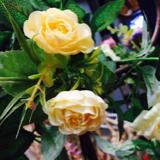
管花杜鹃形态特征
常绿直立灌木,高1-4(--6)米。枝条细长,幼枝带紫红色,疏生鳞片。叶散生 幼枝上,披针状椭圆形或披针状长圆形,长(3--)4-8(--15)厘米,宽1-3(--4) 厘米,顶端锐尖,基部楔形,上面暗绿色,有光泽,被褐色鳞片,鳞片相距为其直径的 1--3倍,下面苍绿色,被密而不等大的褐色至暗褐色的鳞片,相距为其直径或不及,侧脉明显;叶柄长5-12毫米,被鳞片。花序顶生或腋生,短总状,通常有4-6花;花梗长4-8毫米,纤细,带红色,有鳞片;花萼小,长约1毫米,浅5裂或仅为边檐 状,无鳞片;花冠管状,一面稍臌胀,长1.8-2.5厘米,橘红、朱红或肉红色,口部 浅5裂,裂片长圆形,直立;雄蕊10,花药短小,卵圆形,花丝下部被密毛;花柱下 部常被毛,偶尔无毛。蒴果长圆形,长8-10毫米,密被鳞片。花期7月,果期10 月。

管花杜鹃的繁殖方式
扦插繁殖
扦插繁殖是杜鹃花栽培中应用最多的繁殖方法,一般在5-6月份剪取健壮的半木质化的新枝,长约5-8厘米,剪除下部叶片,保留顶叶2-3片作插穗,插穗基部最好用吲哚丁酸或ABT生根粉等溶液浸蘸处理,然后扦插在疏松透气、富含腐植质的酸性土壤中,温度保持在20-25℃,遮阴并经常喷雾保湿,以促进萌发新根。
嫩枝繁殖
嫩枝繁殖是用劈接对于难以成活的名贵品种如西鹃等,先剪去嫩枝约3-4厘米作接穗,将基部用利刀削成楔形,用毛鹃作砧木,采用嫩枝劈接,然后置阴棚下用塑料薄膜绑扎,并用塑料袋将接穗和砧木一起罩住保湿。

管花杜鹃的养殖方法
肥水管理
杜鹃生长发育要求酸性土壤。由于北方土壤多偏碱性,因此盆土需用腐熟的松针叶土等腐植土混合配制。杜鹃的根系为须状细根,对肥料浓度及水质的要求严格,施肥时要遵循适时适量、薄肥勤施的原则。春季开花前为促使枝叶及花蕾生长,可每月追施一次磷肥。花后施1-2次氮磷为主的混合肥料。9-10月份孕蕾期施1-2次磷肥。在生长期、开花期肥水要求较多,冬季休眠、夏季生长缓慢时要控制肥水,以防烂根。杜鹃花喜湿润和凉爽的环境,北方气候干燥,应及时浇水并喷雾,以保持较高空气湿度。浇花水以矾肥水及雨水为好,如用常用水需加入少量硫酸亚铁及食醋。也可将西瓜或西红柿切成小块施入,对于改善土质及花朵质量也有良好效果。
整形修剪
为加速植株盛开,杜鹃常通过摘心来促发新枝,对于花朵簇拥、影响花形的可以提早疏蕾,这样不但使当年花大色鲜,也有利于植株来年生长开花。杜鹃萌发力强,枝条严重影响植株生长发育,降低其观赏性和商品性,因此需通过修枝来调整。修枝一般在春季花谢后及秋季进行,剪去枯枝、斜枝、徒长枝病虫枝及部分交叉枝,避免养分消耗,使整个植株开花丰满。
花期控制
杜鹃在秋季进行花芽分化,通过冷藏和加温处理,可以人为控制花期。要使杜鹃提前开花,可将其移至温室培养,控温在20-25℃,并经常在枝叶上喷水,保持80%以上的相对湿度,这样经过一个半月即可开花。要使杜鹃延迟开花,可将形成花蕾的杜鹃,让其一直处于低温状态,保持温度2-4℃,盆干时浇水,夏秋移出室外,2周后即可开花。
常绿直立灌木,高1-4(--6)米。枝条细长,幼枝带紫红色,疏生鳞片。叶散生 幼枝上,披针状椭圆形或披针状长圆形,长(3--)4-8(--15)厘米,宽1-3(--4) 厘米,顶端锐尖,基部楔形,上面暗绿色,有光泽,被褐色鳞片,鳞片相距为其直径的 1--3倍,下面苍绿色,被密而不等大的褐色至暗褐色的鳞片,相距为其直径或不及,侧脉明显;叶柄长5-12毫米,被鳞片。花序顶生或腋生,短总状,通常有4-6花;花梗长4-8毫米,纤细,带红色,有鳞片;花萼小,长约1毫米,浅5裂或仅为边檐 状,无鳞片;花冠管状,一面稍臌胀,长1.8-2.5厘米,橘红、朱红或肉红色,口部 浅5裂,裂片长圆形,直立;雄蕊10,花药短小,卵圆形,花丝下部被密毛;花柱下 部常被毛,偶尔无毛。蒴果长圆形,长8-10毫米,密被鳞片。花期7月,果期10 月。

管花杜鹃的繁殖方式
扦插繁殖
扦插繁殖是杜鹃花栽培中应用最多的繁殖方法,一般在5-6月份剪取健壮的半木质化的新枝,长约5-8厘米,剪除下部叶片,保留顶叶2-3片作插穗,插穗基部最好用吲哚丁酸或ABT生根粉等溶液浸蘸处理,然后扦插在疏松透气、富含腐植质的酸性土壤中,温度保持在20-25℃,遮阴并经常喷雾保湿,以促进萌发新根。
嫩枝繁殖
嫩枝繁殖是用劈接对于难以成活的名贵品种如西鹃等,先剪去嫩枝约3-4厘米作接穗,将基部用利刀削成楔形,用毛鹃作砧木,采用嫩枝劈接,然后置阴棚下用塑料薄膜绑扎,并用塑料袋将接穗和砧木一起罩住保湿。

管花杜鹃的养殖方法
肥水管理
杜鹃生长发育要求酸性土壤。由于北方土壤多偏碱性,因此盆土需用腐熟的松针叶土等腐植土混合配制。杜鹃的根系为须状细根,对肥料浓度及水质的要求严格,施肥时要遵循适时适量、薄肥勤施的原则。春季开花前为促使枝叶及花蕾生长,可每月追施一次磷肥。花后施1-2次氮磷为主的混合肥料。9-10月份孕蕾期施1-2次磷肥。在生长期、开花期肥水要求较多,冬季休眠、夏季生长缓慢时要控制肥水,以防烂根。杜鹃花喜湿润和凉爽的环境,北方气候干燥,应及时浇水并喷雾,以保持较高空气湿度。浇花水以矾肥水及雨水为好,如用常用水需加入少量硫酸亚铁及食醋。也可将西瓜或西红柿切成小块施入,对于改善土质及花朵质量也有良好效果。
整形修剪
为加速植株盛开,杜鹃常通过摘心来促发新枝,对于花朵簇拥、影响花形的可以提早疏蕾,这样不但使当年花大色鲜,也有利于植株来年生长开花。杜鹃萌发力强,枝条严重影响植株生长发育,降低其观赏性和商品性,因此需通过修枝来调整。修枝一般在春季花谢后及秋季进行,剪去枯枝、斜枝、徒长枝病虫枝及部分交叉枝,避免养分消耗,使整个植株开花丰满。
花期控制
杜鹃在秋季进行花芽分化,通过冷藏和加温处理,可以人为控制花期。要使杜鹃提前开花,可将其移至温室培养,控温在20-25℃,并经常在枝叶上喷水,保持80%以上的相对湿度,这样经过一个半月即可开花。要使杜鹃延迟开花,可将形成花蕾的杜鹃,让其一直处于低温状态,保持温度2-4℃,盆干时浇水,夏秋移出室外,2周后即可开花。
0
0
文章
Colour_
2017年07月11日

忽地笑(学名:Lycoris aurea (L'Hér.) Herb)草本,地生。鳞茎卵形;叶剑形;伞形花序,有花4-8朵,花黄色;花被裂片背面具淡绿色中肋,雄蕊略伸出于花被外,花丝黄色;蒴果具三棱,室背开裂;种子少数,近球形。
分布中国福建、台湾、湖北、湖南、广东、广西、四川、云南等地,多长于阴湿山坡地。

忽地笑养殖方法
土壤
忽地笑的适应性很强,喜欢在阴湿的环境中生长,比较耐寒、耐盐碱,最好选择含有丰富腐殖质的肥沃沙壤土或者石灰质壤土。
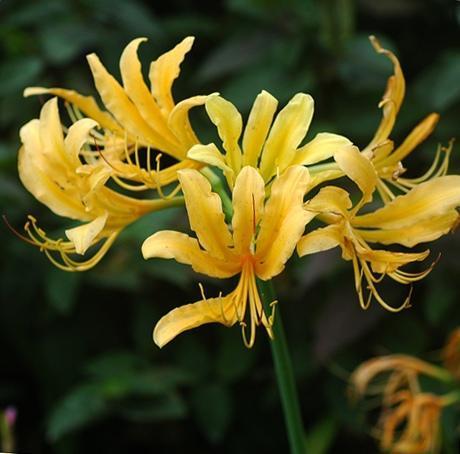
光照
忽地笑不耐旱,怕水涝和阳光暴晒,光照过强时会导致植株不开花,最适合的生长温度为22-30度,平时种植时放置在散光通风处即可。
浇水
忽地笑的日常管理要注意保持土壤湿润,在夏季开花前要是遇到比较干旱的天气,需要连续浇两到三次的水;在植株的休眠期时,要逐步减少浇水的量。
施肥
忽地笑的生长不需要过多的施肥,可以施用一些速效性的化学肥料,用来促进叶片营养生长。在三月到四月期间可以施用少量追肥,可以促进鳞茎的增大;在六月到七月植株的休眠期时,可以施加少量的有机肥;当花茎开始抽出时,可以追施一次稀薄的腐熟磷钾肥。
分布中国福建、台湾、湖北、湖南、广东、广西、四川、云南等地,多长于阴湿山坡地。

忽地笑养殖方法
土壤
忽地笑的适应性很强,喜欢在阴湿的环境中生长,比较耐寒、耐盐碱,最好选择含有丰富腐殖质的肥沃沙壤土或者石灰质壤土。

光照
忽地笑不耐旱,怕水涝和阳光暴晒,光照过强时会导致植株不开花,最适合的生长温度为22-30度,平时种植时放置在散光通风处即可。
浇水
忽地笑的日常管理要注意保持土壤湿润,在夏季开花前要是遇到比较干旱的天气,需要连续浇两到三次的水;在植株的休眠期时,要逐步减少浇水的量。
施肥
忽地笑的生长不需要过多的施肥,可以施用一些速效性的化学肥料,用来促进叶片营养生长。在三月到四月期间可以施用少量追肥,可以促进鳞茎的增大;在六月到七月植株的休眠期时,可以施加少量的有机肥;当花茎开始抽出时,可以追施一次稀薄的腐熟磷钾肥。
0
0






